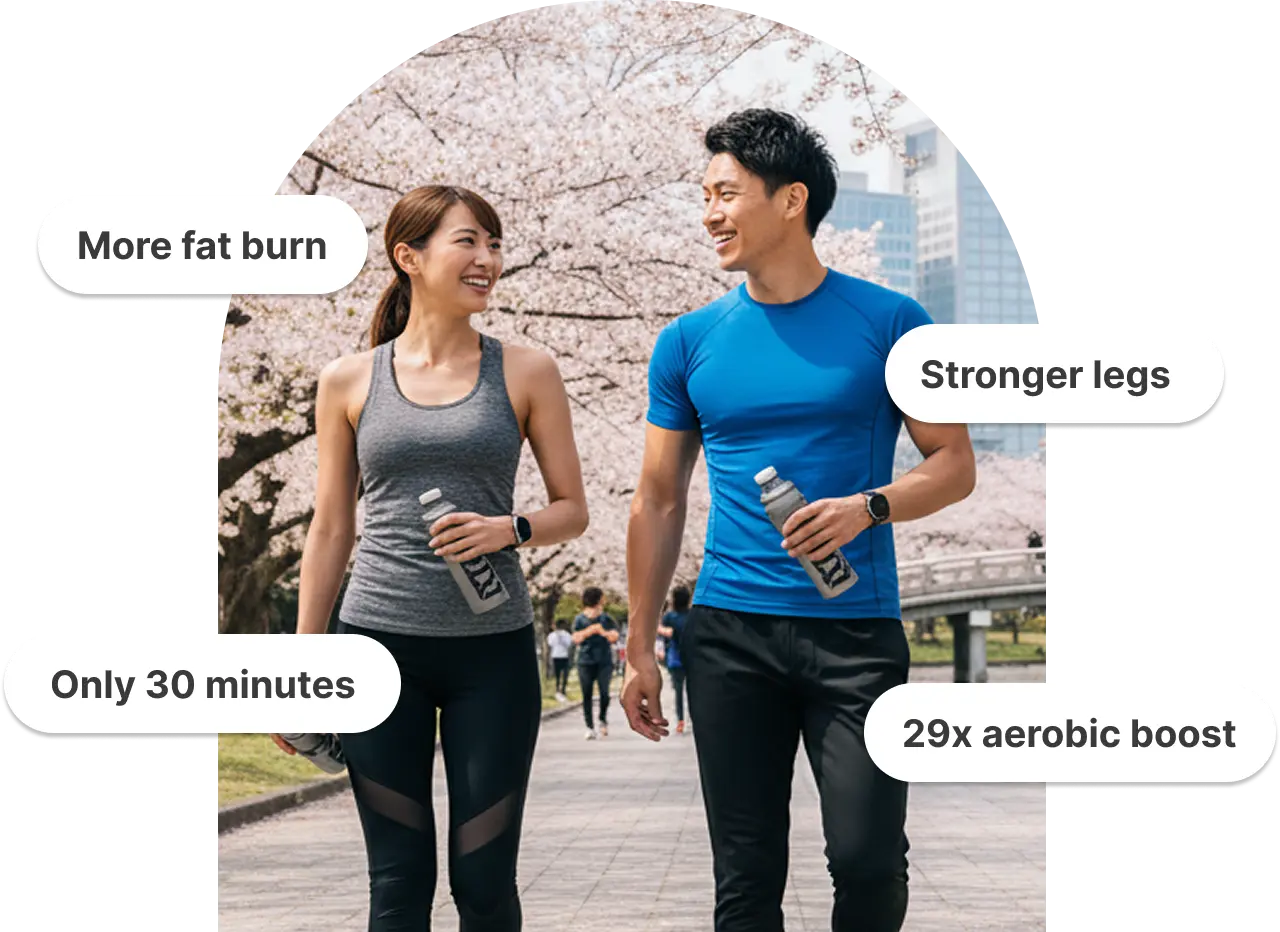Last Updated: October 2025
If you've been struggling to hit 10,000 steps a day, there's good news: a scientifically proven walking method from Japan is delivering better results in just 30 minutes—and it's going viral for all the right reasons.
The Japanese Walking Method (also called Interval Walking Training or IWT) alternates between fast and slow walking in 3-minute intervals. Research shows it can improve your fitness, lower blood pressure, and burn more calories than traditional walking—all in half the time.
In this complete guide, you'll learn exactly how to do Japanese walking, the science behind why it works, and how to get started today.
Table of Contents
What Is the Japanese Walking Method?
The Japanese Walking Method is a 30-minute workout that alternates between fast-paced walking and slow recovery walking in structured intervals.
The basic protocol:
- 3 minutes fast walking (70-85% of your maximum effort)
- 3 minutes slow walking (40-50% of your maximum effort)
- Repeat 5 times for a total of 30 minutes
- Do this 4+ times per week for best results
Unlike traditional walking where you maintain a steady pace, Japanese walking challenges your cardiovascular system with intensity bursts, similar to HIIT (High-Intensity Interval Training) but much gentler on your joints.
✨ Key Difference
Regular Walking: Steady pace, 60-90 minutes to reach 10,000 steps
Japanese Walking: Alternating pace, 30 minutes, more cardiovascular benefits
The Science Behind Japanese Walking: Where Did It Come From?
The Japanese Walking Method isn't a social media fad—it's backed by nearly 20 years of scientific research.
The Original 2007 Study
In 2007, Professor Hiroshi Nose and Dr. Shizue Masuki from Shinshu University in Matsumoto, Japan conducted a groundbreaking study published in Mayo Clinic Proceedings.
They divided 246 participants (average age 63) into three groups:
- Sedentary group – No walking
- Moderate walking group – 8,000 steps daily, 4+ days per week
- Interval walking group – 30 minutes of fast/slow intervals, 4+ days per week
The results after 5 months were striking:
The interval walking group outperformed even those who walked 30,000 steps weekly, showing:
- Greater blood pressure reduction (8-10 points vs 1-2 points)
- 10x improvement in leg strength
- 29x boost in aerobic fitness
- More weight loss
- Better muscle strength
Long-Term Studies Confirm Benefits
A 2018 follow-up study tracking participants over 10 years found even more impressive results:
- 20% increase in leg strength
- 40% increase in peak exercise capacity
- Protection against age-related fitness decline
By 2020, research had examined over 10,000 middle-aged and older adults, confirming that Japanese walking improves symptoms of lifestyle diseases, cognitive function, sleep quality, and even depression.
Japanese Walking vs 10,000 Steps: Which Is Better?
For decades, 10,000 steps has been the gold standard. But did you know this target wasn't based on science?
The Truth About 10,000 Steps
The 10,000-step rule came from a 1964 marketing campaign for a Japanese pedometer called "Manpo-Kei" (literally "10,000 steps meter"), timed with the Tokyo Olympics.
The number was chosen because:
- It was round and memorable
- The Japanese character for 10,000 (万) looks like a person walking
- It sounded impressive for marketing
Recent research shows that health benefits actually plateau around 7,000-8,000 steps—not 10,000.
Side-by-Side Comparison
| Factor | Japanese Walking | 10,000 Steps |
|---|---|---|
| Time Required | 30 minutes | 60-90 minutes |
| Cardiovascular Benefit | High (29x aerobic boost) | Moderate |
| Muscle Strength | Significant gains (10x improvement) | Minimal |
| Blood Pressure Reduction | 8-10 points decrease | 1-2 points decrease |
| Fat Burning | Higher (intensity intervals) | Moderate (steady state) |
| Joint Impact | Low | Low |
| Scientific Evidence | 20+ years of research | Marketing origin, later studied |
| Best For | Time-efficient fitness gains | Daily movement baseline |
Which Should You Choose?
Choose Japanese Walking if you:
- Have limited time (less than 60 minutes daily)
- Want faster cardiovascular improvements
- Are looking to build strength while walking
- Have hit a plateau with regular walking
- Want more efficient calorie burning
Choose 10,000 Steps if you:
- Are just starting a fitness routine
- Prefer steady, mindful walking
- Have all day to accumulate steps
- Want to focus on consistent daily movement
Best Option? Combine both! Do Japanese walking 4x per week for fitness gains, and aim for 7,000-8,000 daily steps for overall health.
7 Science-Backed Benefits of Japanese Walking
1. Burns More Fat Than Regular Walking
The intensity intervals force your body to work harder, increasing calorie expenditure during and after your walk. Your metabolism stays elevated even after you finish, burning more calories throughout the day.
Why it works: Alternating between fast and slow walking creates an "afterburn effect" (EPOC - Excess Post-Exercise Oxygen Consumption) that steady-state walking doesn't provide.
2. Builds Stronger Legs (10x Improvement)
Research shows Japanese walking improves leg muscle strength by 10 times compared to regular walking. Participants in the 10-year study saw 20% stronger legs.
Muscles targeted: Quadriceps, hamstrings, calves, and glutes all get strengthened during the fast intervals.
3. Lowers Blood Pressure (3x Better)
The 2007 study found that Japanese walking lowered systolic blood pressure by 8-10 points in just 5 months—compared to only 1-2 points with regular walking.
Why it matters: High blood pressure is a leading risk factor for heart disease and stroke. This natural method helps regulate it without medication.
4. Boosts Cardiovascular Fitness (29x Aerobic Gains)
Japanese walking significantly improves VO2 max—your body's ability to use oxygen during exercise. Studies show 20% improvements in aerobic capacity.
Real-world benefit: Everyday activities become easier—climbing stairs, carrying groceries, playing with kids or grandkids.
5. Improves Blood Sugar Control
The high-intensity intervals help your muscles absorb blood sugar more effectively, improving insulin sensitivity. Studies show reduced blood glucose levels and lower body mass index (BMI) after 4 months.
Great for: People with prediabetes, type 2 diabetes, or those wanting to prevent metabolic issues.
6. Protects Your Brain and Boosts Mood
Research on 10,000+ adults found Japanese walking improved:
- Cognitive function
- Sleep quality
- Depression symptoms
- Overall mood
Walking outdoors in nature amplifies these mental health benefits even more.
7. Low-Impact and Joint-Friendly
Unlike running, Japanese walking keeps at least one foot on the ground at all times, making it safe for:
- People over 50
- Those with joint issues or arthritis
- Individuals recovering from injury
- Anyone who finds running too strenuous
How to Do Japanese Walking: Step-by-Step Guide
💡 Want a personalized plan? Get your free Japanese walking plan customized to your fitness level and goals.
The Complete Protocol
Total Time: 30 minutes
Frequency: 4-5 times per week minimum
Location: Outdoors preferred (parks, trails, neighborhoods) or treadmill
Step 1: Warm Up (2-3 minutes)
- Walk at an easy pace
- Do ankle circles and shoulder rolls
- Gently increase your pace
Step 2: Fast Interval (3 minutes)
Intensity: 70-85% of maximum effort
How it should feel:
- You can speak, but full conversation is challenging
- Breathing is noticeably harder
- Rate of Perceived Exertion (RPE): 7-8 out of 10
- Like you're late for a flight but not running
Form tips:
- Swing your arms naturally
- Keep core engaged
- Maintain upright posture
- Take quick, purposeful steps
Step 3: Slow Interval (3 minutes)
Intensity: 40-50% of maximum effort
How it should feel:
- Easy conversation is possible
- Breathing returns to near-normal
- RPE: 3-4 out of 10
- Recovery pace—you're still moving but catching your breath
Step 4: Repeat
Complete 5 full cycles (fast/slow) for 30 minutes total.
Step 5: Cool Down (3-5 minutes)
- Walk at an easy pace
- Stretch calves, hamstrings, and quads
- Do a few slow heel raises
How to Measure Your Intensity
If you don't have a fitness tracker to monitor heart rate, use the "talk test":
- Fast pace: Can speak 3-4 words at a time, but sentences are difficult
- Slow pace: Can hold a full conversation comfortably
Pro tip: Most fitness trackers and smartwatches can set custom interval timers that buzz when it's time to switch pace.
Japanese Walking for Beginners: How to Start Safely
If you're new to exercise or haven't walked regularly, here's how to ease into Japanese walking without overwhelming yourself.
Week 1-2: Modified Protocol (15 minutes)
- 2 minutes slow walk warm-up
- 1 minute fast + 2 minutes slow (repeat 4 times = 12 minutes)
- 1 minute cool down
Goal: Build confidence and get used to changing pace
Week 3-4: Increased Intervals (20 minutes)
- 2 minutes warm-up
- 2 minutes fast + 2 minutes slow (repeat 4 times = 16 minutes)
- 2 minutes cool down
Goal: Increase duration while maintaining form
Week 5+: Full Protocol (30 minutes)
- 2 minutes warm-up
- 3 minutes fast + 3 minutes slow (repeat 5 times = 30 minutes)
- 3 minutes cool down
Goal: Complete the authentic Japanese walking protocol
Beginner-Friendly Tips
- Start with fewer days: Try 2-3 times per week initially, then increase to 4-5
- Choose flat routes first: Avoid hills until you're comfortable with the intervals
- Listen to your body: If you feel breathless or dizzy, slow down
- Use a fitness tracker: Track your progress and set interval timers
- Walk with a buddy: Having a partner keeps you accountable and motivated
- Don't skip rest days: Recovery is when your body gets stronger
Who Should Consult a Doctor First?
Japanese walking is safe for most people, but talk to your doctor before starting if you have:
- Heart conditions or high blood pressure
- Joint problems or previous injuries
- Balance issues or dizziness
- Diabetes (to adjust medication if needed)
- Been sedentary for over 6 months
Common Mistakes to Avoid
Mistake #1: Not Walking Fast Enough
The problem: If your "fast" intervals don't elevate your heart rate significantly, you won't get the full benefits.
The fix: During fast intervals, you should find continuous conversation difficult. Use the talk test to check.
Mistake #2: Skipping the Warm-Up
The problem: Jumping straight into fast walking without warming up increases injury risk.
The fix: Always start with 2-3 minutes of easy walking to prepare your muscles.
Mistake #3: Poor Posture
The problem: Slouching or looking down reduces the effectiveness and can cause back pain.
The fix: Keep your:
- Head up, eyes forward
- Shoulders back and relaxed
- Core engaged
- Arms swinging naturally
Mistake #4: Doing It Every Day
The problem: Your body needs rest to recover and build strength.
The fix: Stick to 4-5 times per week. On rest days, do light stretching or leisurely walking.
Mistake #5: Not Tracking Progress
The problem: Without tracking, you can't see improvements or adjust your routine.
The fix: Record:
- Date and time
- How you felt (energy, difficulty)
- Distance covered
- Average heart rate (if possible)
Mistake #6: Wearing the Wrong Shoes
The problem: Unsupportive shoes can cause blisters, pain, and injury.
The fix: Wear walking or running shoes with:
- Good cushioning
- Arch support
- Proper fit (no blisters)
Frequently Asked Questions About Japanese Walking
How many calories does Japanese walking burn?
Japanese walking burns approximately 150-250 calories in 30 minutes, depending on your weight, speed, and intensity. This is 30-40% more than steady-paced walking for the same duration due to the interval effect.
Can I do Japanese walking on a treadmill?
Yes! Japanese walking works perfectly on a treadmill. Simply adjust the speed for your fast and slow intervals. However, walking outdoors provides additional mental health benefits from nature exposure and varied terrain.
How soon will I see results?
Most people notice improvements within 2-4 weeks:
- Week 1-2: More energy, better mood
- Week 3-4: Easier to maintain fast pace, less breathlessness
- Week 8-12: Measurable improvements in blood pressure, strength, endurance
- 5 months: Full benefits similar to research studies
Is Japanese walking better than running?
They serve different purposes. Japanese walking is:
- Better for: Joint health, accessibility, consistency, beginners, older adults
- Running is better for: Maximum calorie burn, bone density, advanced fitness goals
Many people use Japanese walking as a complement to running or as a recovery workout.
Can I listen to music or podcasts?
Yes, but with caveats:
- Use one earbud to stay aware of surroundings
- Set interval timer alerts that override audio
- For outdoor walks, consider bone conduction headphones for safety
Some people find that music with varying tempos naturally guides their intervals.
What's the difference between Japanese walking and power walking?
Power walking maintains a consistently fast pace throughout. Japanese walking alternates between fast and slow, which:
- Provides recovery periods
- Is more sustainable long-term
- Offers greater cardiovascular benefits
- Is easier for beginners
Should I do Japanese walking before or after meals?
Best timing:
- Before breakfast: Fasted cardio can enhance fat burning
- After meals: Helps control blood sugar (wait 30-60 minutes)
- Avoid: Immediately after eating or when overly full
Can I do Japanese walking if I'm over 60?
Absolutely! The method was specifically designed for older adults. The original study had participants with an average age of 63. Benefits for seniors include:
- Prevents age-related strength loss
- Improves balance and coordination
- Protects cognitive function
- Reduces risk of chronic diseases
Do I need to count steps during Japanese walking?
No! That's one of the beauties of this method. Instead of obsessing over step count, you focus on time and intensity. A typical 30-minute session will give you approximately 3,000-4,000 steps—so you can combine Japanese walking with additional daily movement to reach 7,000-8,000 total steps.
Can Japanese walking help with weight loss?
Yes! While no single exercise guarantees weight loss (diet matters most), Japanese walking supports weight loss by:
- Burning more calories than steady walking
- Boosting metabolism
- Building muscle (which burns more calories at rest)
- Improving insulin sensitivity
- Being sustainable long-term
Combine Japanese walking 4-5 times per week with a balanced diet for best results.
What if I can't complete the full 30 minutes?
That's completely fine! Start where you are:
- Break it into 3 x 10-minute sessions throughout the day
- Begin with 15 minutes and gradually increase
- Reduce the fast interval intensity
- Take extra recovery time between intervals
The key is consistency, not perfection.
Getting Started with Japanese Walking Today
The Japanese Walking Method isn't just another fitness trend—it's a scientifically proven, time-efficient way to improve your health in just 30 minutes, 4 times per week.
Here's your action plan:
- This week: Try one modified session (15-20 minutes) to get comfortable with intervals
- Week 2-4: Build up to the full 30-minute protocol
- Week 5+: Make it a habit by scheduling 4-5 sessions per week
- Track progress: Note how you feel, your energy levels, and any physical changes
Remember: The best exercise is the one you'll actually do consistently. Japanese walking works because it's:
- Simple to learn
- Time-efficient
- Low-impact and safe
- Backed by decades of research
- Suitable for all fitness levels
🎯 Get Your FREE Personalized Japanese Walking Plan
Ready to start today? Get a custom Japanese walking plan tailored to your:
- ✅ Current fitness level
- ✅ Weight loss goals
- ✅ Available time
- ✅ Age and experience
Create Your Free Japanese Walking Plan →
Takes less than 60 seconds. No credit card required.
"Any social media trend that gets people moving is one that I will subscribe to as a sports medicine clinician. The Japanese walking method offers real, measurable benefits backed by solid research."
— Dr. Amanda Doperak, Sports Medicine Specialist
Scientific References
- Nemoto K, Gen-no H, Masuki S, Okazaki K, Nose H. Effects of high-intensity interval walking training on physical fitness and blood pressure in middle-aged and older people. Mayo Clin Proc. 2007;82(7):803-811.
- Masuki S, Nose H. Review of interval walking training and its potential as a countermeasure to age-related health problems. Phys Fit Sports Med. 2020.
- Paluch AE, et al. Daily steps and all-cause mortality: a meta-analysis. Lancet Public Health. 2022.



